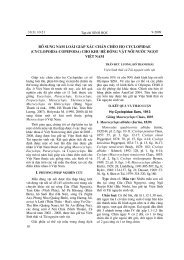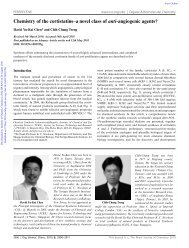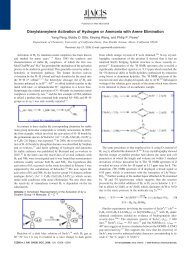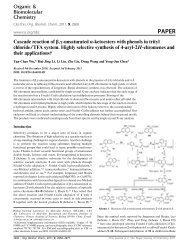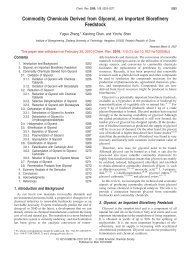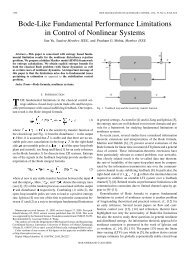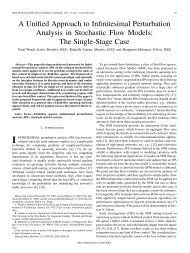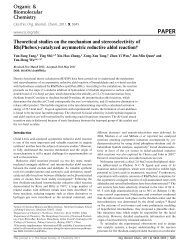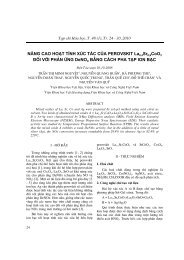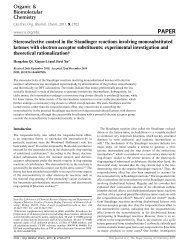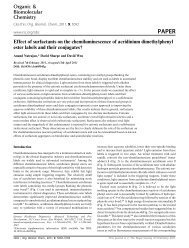Fig. 10 Relative fluorescence ratio (I 670/I 0) <strong>of</strong> SQ (5 mM) in the presence <strong>of</strong> CTAB (333 mM) in phosphate buffer (10 mM, pH 7.2) upon addition <strong>of</strong> different ions (0–0.2 mM). The broken line on the ATP curve shows the linear correlation between the fluorescence response <strong>and</strong> ATP concentration (0–140 mM). electrostatic interaction between the oppositely-charged species CTAB–ATP <strong>and</strong> ATP–SQ, in contrast to the assemblies I <strong>and</strong> II that involved the interaction <strong>of</strong> two positively charged species. Excessive CTAB could turn on the fluorescence <strong>of</strong> SQ (Fig. 5), since the increasing micelle concentration makes the formation <strong>of</strong> I <strong>and</strong> II a more competitive process. It was assumed that the SQ was attracted to the phosphate group <strong>of</strong> ATP through electrostatic interaction. In this step, the two phosphate groups appeared to be necessary (one attaching to positively charged surface <strong>of</strong> the spherical micelle, the other to SQ) for the <strong>assembly</strong>. This was likely to be the reason for the selective recognition <strong>of</strong> ATP over AMP, adenosine, phosphate <strong>and</strong> other anions. The p–p stacking interaction between SQ backbone <strong>and</strong> the aromatic segment <strong>of</strong> ATP could also play an important role in the stability <strong>of</strong> the SQ–ATP–micelle <strong>assembly</strong>, 23 which accounted for the selective recognition <strong>of</strong> ATP over PPi. The different response between the nucleotide triphosphates ATP <strong>and</strong> GTP (Fig. 9 <strong>and</strong> 10) further pointed to the fact that the p– p stacking interaction could be used to differentiate different triphosphates. Owing to steric hindrance, SQ molecules had a tendency to exist in J-aggregate form rather than H-aggregate form in the cavity <strong>of</strong> the SQ–ATP–micelle <strong>assembly</strong> (Scheme 1). Observation <strong>of</strong> a new b<strong>and</strong>, 664 nm in absorption <strong>and</strong> 676 nm in fluorescence, is consistent <strong>with</strong> the proposed ternary structure. The moderate selectivity between ATP <strong>and</strong> ADP was associated <strong>with</strong> the length <strong>of</strong> phosphates, as the triphosphate provided more space to accommodate the SQ aggregates, which can simultaneously interact <strong>with</strong> the phosphate (electrostatic interaction) <strong>and</strong> adenosine segments (p–p interaction). To detect ATP in the biological system, it is necessary to assess the selectivity in the presence <strong>of</strong> alkali <strong>and</strong> alkali-earth metal cations. It is known that ATP can bind cations Mg 2+ (at 9554 M -1 ), Ca 2+ (at 3722 M -1 ), Na + (at 13 M -1 )<strong>and</strong>K + (at 8 M -1 ). 24 The influence <strong>of</strong> various cations on the fluorescence <strong>of</strong> SQ was examined by addition <strong>of</strong> Na + ,K + ,Ca 2+ <strong>and</strong> Mg 2+ (Fig. S12, ESI†). In the presence <strong>of</strong> 0.2 mM <strong>of</strong> various cations, Na + <strong>and</strong> K + exhibit little influence on the fluorescence enhancement, whereas thepresence<strong>of</strong>Ca 2+ <strong>and</strong> Mg 2+ suppressed the fluorescence increase to some extent. However, these results do not interfere <strong>with</strong> the sensing process. Conclusions In summary, we have demonstrated a new ternary system, which incorporates ATP <strong>and</strong> SQ into an ordered molecular self-<strong>assembly</strong> to induce fluorescence turn-on. The molecular <strong>assembly</strong> is driven by a balanced electrostatic interaction <strong>and</strong> p–p stacking <strong>of</strong> the aromatic segment <strong>of</strong> ATP <strong>and</strong> SQ. The sensor operates by attenuating the aggregate structure <strong>of</strong> <strong>squaraine</strong> <strong>dye</strong>s (from H- to monomer <strong>and</strong> J-aggregates) under physiological pH conditions. The study provides a simple approach for the detection <strong>of</strong> ATP. Due to the specific requirements for the analyte to enter the nano-structured molecular <strong>assembly</strong>, the ternary system exhibits good selectivity to sense ATP. The new sensor system provides an additional example Fig. 11 Micelle-based equilibrium to redistribute the H-aggregate SQ into monomeric <strong>and</strong> aggregate form. This journal is © The Royal Society <strong>of</strong> Chemistry 2011 Org. Biomol. Chem., 2011, 9, 2878–2884 | 2883
that operates by recognizing a specific pattern transformation (i.e. here from H- to J-aggregate) that has the advantage <strong>of</strong> simpler molecular design in comparison <strong>with</strong> typical sensors. 25 This is because the synthesis <strong>of</strong> a classical fluorescent sensor <strong>of</strong>ten involves a lengthy synthetic procedure. Supramolecular <strong>assembly</strong> using easily accessible components, therefore, could provide a costeffective solution. Acknowledgements This work was supported by The University <strong>of</strong> Akron <strong>and</strong> Coleman endowment. References 1 R. Martinez-Manez <strong>and</strong> F. Sancenon, Chem. Rev., 2003, 103, 4419. 2(a) A. Ojida, I. Takashima, T. Kohira, H. Nonaka <strong>and</strong> I. Hamachi, J. Am. Chem. Soc., 2008, 130, 12095; (b) S. Jaeger, G. Rasched, H. Kornreich-Leshem, M. Engeser, O. Thum <strong>and</strong> M. Famulok, J. Am. Chem. Soc., 2005, 127, 15071. 3S.Törnroth-Horsefield <strong>and</strong> R. Neutze, Proc. Natl. Acad. Sci. U. S. A., 2008, 105, 19565. 4 S. Murugappa <strong>and</strong> S. P. Kunapuli, Front. Biosci., 2006, 12, 1977. 5(a) S. M. Butterfield <strong>and</strong> M. L. Waters, J. Am. Chem. Soc., 2003, 125, 9580; (b) D. A. Jose, S. Mishra, A. Ghosh, A. Shrivastav, S. K. Mishra <strong>and</strong> A. Das, Org. Lett., 2007, 9, 1979; (c) P. L. Sazani, R. Larralde <strong>and</strong> J. W. Szostak, J. Am. Chem. Soc., 2004, 126, 8370; (d) D. Miyamoto, Z. Tang, T. Takarada <strong>and</strong> M. Maeda, Chem. Commun., 2007, 4743; (e) D.H.Lee,S.Y.Kim<strong>and</strong>J.I.Hong,Angew. Chem., Int. Ed., 2004, 43, 4777; (f) Y. Kanekiyo, R. Naganawa <strong>and</strong> H. Tao, Chem. Commun., 2004, 1006; (g) J. A. Cruz-Aguado, Y. Chen, Z. Zhang, N. H. Elowe, M. A. Brook <strong>and</strong> J. D. Brennan, J. Am. Chem. Soc., 2004, 126, 6878; (h) P. P. Neelak<strong>and</strong>an, M. Hariharan <strong>and</strong> D. Ramaiah, Org. Lett., 2005, 7, 5765; (i) C. Li, M. Numata, M. Takeuchi <strong>and</strong> S. Shinkai, Angew. Chem., Int. Ed., 2005, 44, 6371. 6(a) S. Das, K. G. Thomas, R. Ramanathan <strong>and</strong> M. V. George, J. Phys. Chem., 1993, 97, 13625; (b) K.Y.Law,J. Phys. Chem., 1987, 91, 5184. 7(a) P. Chithra, R. Varghese, K. P. Divya <strong>and</strong> A. Ajayaghosh, Chem.– Asian J., 2008, 3, 1365; (b) S. Alex, M. C. Basheer, K. T. Arun, D. Ramaiah <strong>and</strong> S. Das, J. Phys. Chem. A, 2007, 111, 3226; (c) R. S. Stoll, N. Severin, J. P. Rabe <strong>and</strong> S. Hecht, Adv. Mater., 2006, 18, 1271. 8 S. Gadde, E. K. Batchelor, J. P. Weiss, Y. Ling <strong>and</strong> A. E. Kaifer, J. Am. Chem. Soc., 2008, 130, 17114. 9 M. Morikawa, M. Yoshihara, T. Endo <strong>and</strong> N. Kimizuka, J. Am. Chem. Soc., 2005, 127, 1358. 10 F. J. M. Hoeben, P. Jonkheijm, E. W. Meijer <strong>and</strong> A. P. H. J. Schenning, Chem. Rev., 2005, 105, 1491–1546. 11 (a) S. Ozeki <strong>and</strong> S. Ikeda, J. Colloid Interface Sci., 1982, 87, 424–435; (b) M. Drifford, L. Belloni <strong>and</strong> M. Dubois, J. Colloid Interface Sci., 1987, 118, 50–67; (c) N. Funasaki <strong>and</strong> S. Hada, Bull. Chem. Soc. Jpn., 1991, 64, 682–684; (d) A. Tanaka <strong>and</strong> S. Ikeda, Colloids Surf., 1991, 56, 217–228. 12 (a) P. Gr<strong>and</strong>ini, F. Mancin, P. Tecilla, P. Scrimin <strong>and</strong> U. Tonellato, Angew. Chem., Int. Ed., 1999, 38, 3061–3064; (b) F. Mancin, P. Tecilla, P. Scrimin <strong>and</strong> U. Tonellato, Coord. Chem. Rev., 2009, 253, 2150–2165; (c) P. Pallavicini, Y. A. Diaz-Fern<strong>and</strong>ez <strong>and</strong> L. Pasotti, Coord. Chem. Rev., 2009, 253, 2226–2240. 13 (a) M. A. Azagarsamy, V. Yesilyurt <strong>and</strong> S. Thayumanavan, J. Am. Chem. Soc., 2010, 132, 4550–4551; (b) J. –H. Ryu, R. Roy, J. Ventura <strong>and</strong> S. Thayumanavan, Langmuir, 2010, 26, 7086–7092; (c) D. C. Gonzalez, E. N. Savariar <strong>and</strong> S. Thayumanavan, J. Am. Chem. Soc., 2009, 131, 7708–7716; (d) E. N. Savariar, S. Ghosh, D. C. Gonzalez <strong>and</strong> S. Thayumanavan, J. Am. Chem. Soc., 2008, 130, 5416–5417; (e) B.S. S<strong>and</strong>anaraj, R. Demont <strong>and</strong> S. Thayumanavan, J. Am. Chem. Soc., 2007, 129, 3506–3507; (f) Y. Nakahara, T. Kida, Y. Nakatsuji <strong>and</strong> M. Akashi, Chem. Commun., 2004, 224–225. 14 (a) T. Riis-Johannessen <strong>and</strong> K. Severin, Chem.–Eur. J., 2010, 16, 8291– 8295; (b) P. Pallavicini, Y. A. Diaz-Fern<strong>and</strong>ez <strong>and</strong> L. Pasotti, Analyst, 2009, 134, 2147–2152; (c) G. Chirico, M. Collini, L. D’Alfonso, F. Denat, Y. A. Diaz-Fern<strong>and</strong>ez, L. Pasotti, Y. Rousselin, N. Sok <strong>and</strong> P. Pallavicini, ChemPhysChem, 2008, 9, 1729–1737; (d) P. Pallavicini, Y. A. Diaz-Fern<strong>and</strong>ez, F. Foti, C. Mangano <strong>and</strong> S. Patroni, Chem.–Eur. J., 2006, 13, 178–187; (e) R. R. Avirah, K. Jyothish <strong>and</strong> D. Ramaiah, Org. Lett., 2007, 9, 121–124. 15 (a) U. R. K. Rao, C. Manohar, B. S. Valaulikar <strong>and</strong> R. M. Iyer, J. Phys. Chem., 1987, 91, 3286; (b) G. D. Gokhale, P. A. Hassan <strong>and</strong> S. D. Samant, J. Surfactants Deterg., 2005, 8, 319. 16 H. Fenniri, M. W. Hosseini <strong>and</strong> J. –M. Lehn, Helv. Chim. Acta, 1997, 80, 786. 17 P. F. Santos, L. V. Reis, I. Duarte, J. P. Serrano, P. Almeida, A. S. Oliveira <strong>and</strong> L. F. Vieira Ferreira, Helv. Chim. Acta, 2005, 88, 1135. 18 (a) G. Y. Guralchuk, I. K. Katrunov, R. S. Grynyov, A. V. Sorokin, S. L. Yefimova, I. A. Borovoy <strong>and</strong> Y. V. Malyukin, J. Phys. Chem. C, 2008, 112, 14762–14768; (b) S. L. Yefimova, G. Y. Guralchuk, A. S. Lebed, A. V. Sorokin, Y. V. Malyukin <strong>and</strong> I. Y. Kurilchenko, Funct,. Mater., 2009, 16, 460–464. 19 (a) R. B. Singh, S. Mahanta <strong>and</strong> N. Guchhait, Chem. Phys. Lett., 2008, 463, 183; (b) A. Mohr, P. Talbiersky, H. G. Korth, R. Sustmann, R. Boese, D. Blaeser <strong>and</strong> H. Rehage, J. Phys. Chem. B, 2007, 111, 12985; (c) Critical micelle concentration (CMC) <strong>of</strong> CTAB is affected by buffer, see reference: B. Jiang, J. Du, S. Cheng, Q. Wang <strong>and</strong> X. Zeng, J. Dispersion Sci. Technol., 2003, 24, 755–760. 20 K. T. Arun <strong>and</strong> D. Ramaiah, J. Phys. Chem. A, 2005, 109, 5571. 21 Y. Xu, Z. Li, A. Malkovskiy, S. Sun <strong>and</strong> Y. Pang, J. Phys. Chem. B, 2010, 114, 8574–8580. 22 (a) S. Shinkai, M. Ikeda, A. Sugasaki <strong>and</strong> M. Takeuchi, Acc. Chem. Res., 2001, 34, 494; (b) Y. B. Ruan, A. F. Li, J. S. Zhao, J. S. Shen <strong>and</strong> Y. B. Jiang, Chem. Commun., 2010, 46, 4938–4940. 23 (a) Z. Xu, N. J. Singh, J. Lim, J. Pan, H. N. Kim, S. Park, K. S. Kim <strong>and</strong> J. Yoon, J. Am. Chem. Soc., 2009, 131, 15528–15533; (b) Z. Chen, A.Lohr,C.R.Saha-MÖller <strong>and</strong> F. WÜrthner, Chem. Soc. Rev., 2009, 38, 564–584. 24 J. E. Wilson <strong>and</strong> A. Chin, Anal. Biochem., 1991, 193, 16. 25 (a) J. J. McEwen <strong>and</strong> K. J. Wallace, Chem. Commun., 2009, 42, 6339– 6351; (b) E. Arunkumar, A. Ajayaghosh <strong>and</strong> J. Daub, J. Am. Chem. Soc., 2005, 127, 3156–3164; (c) E. Arunkumar, P. Chithra <strong>and</strong> A. Ajayaghosh, J. Am. Chem. Soc., 2004, 126, 6590–6598. 2884 | Org. Biomol. Chem., 2011, 9, 2878–2884 This journal is © The Royal Society <strong>of</strong> Chemistry 2011



